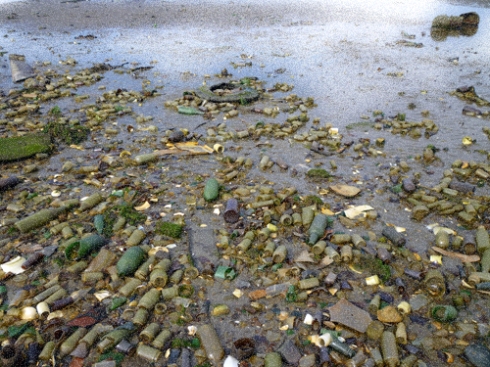
When my boyfriend first told me about Dead Horse Bay, I pictured a beach strewn with whole horse carcasses, bare to the bone, rising up out of the shoreline. In my mind, I saw wildly rearing horse skeletons that would dominate the landscape and create an eerie world for me to walk through. So pervasive was this thought for me, that I began to call the bay Horse Head Bay since my imagination was rife with horse heads forever caught in the sands of time. Alas, in reality, none of this is true.
Dead Horse Bay has a rich history, much like the rest of New York City. From the New York Times archives: Dead Horse Bay sits at the western edge of a marshland once dotted by more than two dozen horse-rendering plants, fish oil factories and garbage incinerators. From the 1850’s until the 1930’s, the carcasses of dead horses and other animals from New York City streets were used to manufacture glue, fertilizer and other products at the site. The chopped-up, boiled bones were later dumped into the water. The squalid bay, then accessible only by boat, was reviled for the putrid fumes that hung overhead. A rugged community of laborers, many of them Irish, Polish and Italian immigrants, lived in relative isolation on neighboring Barren Island, which shared the bay’s unsavory reputation.
After schools of menhaden were discovered in the surrounding waters in the 1860’s, fish oil plants were established along Dead Horse Bay. The oil was used to tan leather and mix paints and the scraps were used to make fertilizer. When the factories faded in the 1890’s, the New York Sanitary Utilization Company was established to transform city garbage into grease, soap and fertilizer. The processing and horse-rendering industries, at their peak, supported a population of 1,500. Barren Island, however, had no public water, sewage system or fire department, and nearby communities complained endlessly about the horrendous stench of its factories.
Yep, “chopped-up, boiled bones” were dumped into the water. So there aren’t any whole bones, just bits and pieces. But more fun are the hundreds and hundreds of old bottles that you can pick through, each one holding potential for a story from days gone by. Old Listerine glass bottles, Coca-Cola bottles, salt and pepper shakers, glass inkwells, and on and on and on. Omigosh, we spent nearly two hours digging, rinsing and reading through bottles that reflect spending habits from over a hundred years ago. Truly, this has been one of the best outings we’ve done to date. I loved the morning sunshine, fresh salty breezes, and the careful steps that created a magical experience. We even found a live horseshoe crab that needed rescuing, which we did.
As you walk along you discover different layers and areas where glass or metal parts were dumped, giving you another picture of how the garbage of the time had been organized. By the time we headed home, I had a nice bag of old bottles to clean and see what I had found. The best part of the day may have been the wonderful, delicious briny scent of the ocean permeating my bathroom as I cleaned and scrubbed.
Here are some fantastic photos of the day and of our treasures. There’s even one of me as my beachbummiest self, appearing as if I am growing out of the sand (I actually do I have real feet). Enjoy!

Leave a comment
Comments feed for this article